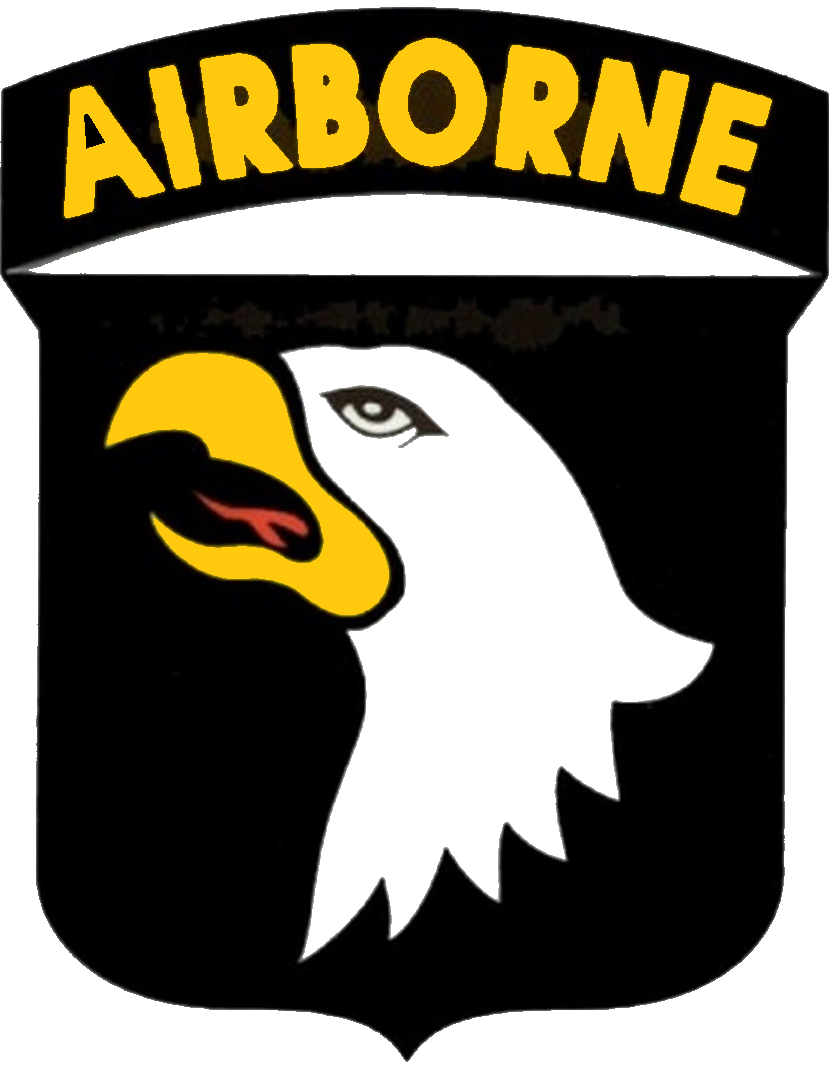U.S. 101st Airborne Division

June, 1944
Division Headquarters:
(Brigadier General General Maxwell D. Taylor, Commanding General.
Promoted to Major General after Normandy)
Headquarters Company. 56 officers and 114 men.
501st Parachute Infantry Regiment: (Col. Howard R. 'Jumpy' Johnson)
Regimental HQ Company
1 Antitank Company (12 57mm AT guns)
1 Cannon Company (6 105mm Howitzers)
1 Service Company
1 Regimental S-2 platoon (Served as Reconnaissance)
3 Battalions Infantry, each with:
Battalion Headquarters Company.( 7 Officers and 165 men.)
8x .30cal LMG
4x 81mm mortars
9x Bazookas
3 Rifle Companies (8 Officers and 168 men.), each with:
Headquarters and 3 Rifle Platoons.
Each Rifle Platoon:
1 Mortar squad (1 60mm mortar)
3 Squads (12 men each). Composition:
Squad weapons:
1 BAR (subject to argument, LMG was used instead)
1 .30 cal LMG
2 .30cal carbines
10 M-1 Garand Rifles
A load of paratroopers carried in one plane (usually a squad) is called a "stick".
502nd Parachute Infantry Regiment
(Col. George V. H. Moseley, Jr.)
NOTE: Moseley broke his leg landing on D-Day. Lt. Col. John H. 'Mike' Michaelis assumed command.
Organized as above.
506th Parachute Infantry Regiment: (Col. Robert F. Sink)
Organized as above.
327th Glider Infantry Regiment
(Col. George S. Wear, Lt. Col. Joseph H. 'Bud' Harper from June 10, 1944)
Regimental HQ Company
1 Service Company
1 ATk Company (9x 37mm towed ATk guns, 9x Bazookas)
2 Battalions Infantry (each):
(1st bttn, 401st Glider Infantry Rgt was attached as a third battalion)
Battalion Headquarters Company (3 37mm AT guns, 6 81mm mortars, 4 .30cal HMGs
6 .30cal LMGs, 8 Bazookas). HMGs were officially removed in September 1944.
Battalion Weapons Company (6 81mm mortars, 8 .30 HMG)
3 Rifle Companies (each) of HQ, 2 Rifle Platoons and a Weapons Platoon
1 Weapons Platoon. Weapons:
2 .30 Browning LMG
3 60mm Mortars (1 was in Company HQ)
2 Rifle Platoons (each):
3 Squads (12 men each). Composition:
1 Sergeant
1 Lance Corporal
2 Corporals
8 Men.
Squad weapons:
1 BAR
1 1903 Springfield Rifle
10 M-1 Garand Rifles
1/327 was transported to Normandy in naval vessels. 1/401 landed at Utah Beach and used causeway 2 to move inland.
Division Reconnaissance Platoon:
3 officers and 61 men.
2 Reconnaisance Sections (jeeps w/.50 cal MG)
1 Mortar Squad
1 Pioneer and demolition squad
3 officers and 61 enlisted men.
326th Airborne Engineer Battalion (LTC John C. Pappas (KIA 13 June, 1944),
then Major Hugh A. Mozley.):
23 officers and 469 men.
HQ and Service Company
1 Parachute Company
2 Glider Companies
326th Airborne Medical Company:
27 officers and 273 enlisted men.
Division Military Police Platoon:
3 officers and 83 enlisted men.
426th Airborne Quartermaster Company:
11 officers and 197 enlisted.
801st Ordnance Company:
9 officers and 99 men.
101st Airborne Signal Company:
10 officers and 275 men.
81st Airborne Anti-Aircraft Anti-Tank Battalion: ( LTC X.B. Cox)
35 officers and 606 men
3 Batteries of 8 57mm AT guns
3 Batteries of 12 .50cal MG
Divisional Artillery: (Brig. Gen. Anthony C. McAuliffe)
133 officers and 1844 men
Headquarters & HQ Bty
Divisional Air Section (10 liaison aircraft)
377th Parachute Field Artillery Battalion (Light) (LTC Benjamin Weisberg)
16 75mm howitzers. Supported 502nd PIR.
321st Glider Field Artillery Battalion (Light) 12 75mm howitzers
907th Glider Field Artillery Battalion (Light) 12 75mm howitzers
Each Battalion: HQ & HQ Bty, Service Bty, 3-4 Firing Batteries
Light Artillery: Battery of 4 75mm pack howitzers
Pathfinders:
Pathfinder teams would drop about an hour ahead of the main force and use
their equipment to help guide in the rest of the unit. Teams were made up of
9-14 signallers with two Eureka ground radar sets and nine Halifane lights, and a 5-man security detachment. The lights were to be set out in a "T", with a different color for each drop zone (DZ), with the tail light flashing out the letter of the DZ in Morse code.
There were usually three sticks of Pathfinders per Regiment.
The Base Stick (2/501) and the Primary Stick (1/501) landed on DZ D
at Normandy. The alternate stick (3/501) landed near Hiesville at DZ C.
Gliders:
CG-4A Waco: US-built gliders' payload was 3750lb. (13 men, a 57mm gun with crew, or a jeep with trailer).
Horsa: UK-built glider's payload was 6700lb. (32 men, or a jeep and howitzer).
Call Signs:
All radio call signs began with "K":
101 Division: Kangaroo
501 Rgt: Klondike
502 Rgt: Kickoff
506 Rgt: Kidnap
327 Rgt: Keepsake
Attached Units:
Co D, 70th Tk Bn 6 Jun 44-16 Jun 44
Co F, 70th Tk Bn 7 Jun 44-
65th Armd FA Bn 6 Jun 44-26 Jun 44
Sources:
Mark A. Bando, The 101st Airborne at Normandy, Motorbooks Intl, Osceola, WI, 1994.
Mark Bando, The 101st Airborne From Holland to Hitler's Eagle's Nest, Motorbooks Intl, Osceola, WI, 1995.
George Forty, U.S. Army Handbook 1939-1945, Charles Scribner's Sons, NY, 1980.
Winston G. Ramsey, ed.,D-Day Then and Now, Vol I, Battle of Britain Prints Intl. Ltd., London, 1995.
U.S. Army Center for American History website:
http://www.army.mil/cmh-pg/documents/ETO-OB/101ABN-ETO.htm
Trigger Time: Mark Bando's excellent website:
http://www.101airborneww2.com/
http://www.101airborneww2.com/warstories6.html

